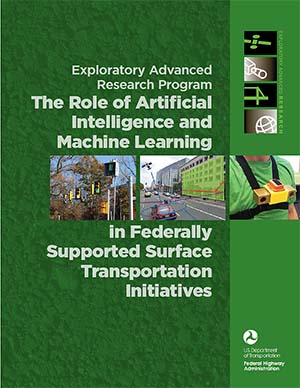U.S. Department of Transportation
Federal Highway Administration
1200 New Jersey Avenue, SE
Washington, DC 20590
202-366-4000
Federal Highway Administration Research and Technology
Coordinating, Developing, and Delivering Highway Transportation Innovations
| BROCHURE |
| This brochure is an archived publication and may contain dated technical, contact, and link information |
| Publication Number: FHWA-HRT-18-066 Date: December 2018 |
Publication Number: FHWA-HRT-18-066 Date: December 2018 |
PDF Version (6.28 MB)
PDF files can be viewed with the Acrobat® Reader®
When people hear the phrase “artificial intelligence,” they might think of robots and machines that perform efficiently and quickly some of the functions that humans do, such as translating signs in a foreign language, or of robotic dogs that comfort older adults. When defined within the context of the transportation sector, artificial intelligence conjures up futuristic images of cars that can drive by themselves, taking into account factors such as speed, the distances of nearby cars, and weather conditions.
Artificial intelligence within transportation does include highly automated vehicles. Further, the use of artificial intelligence through enabling computers to digest and analyze large amounts of data and form conclusions—a process known as machine learning—can provide broad public benefits to transportation in numerous ways. It can improve traffic flows at individual signalized intersections, along specific routes as part of integrated corridor management, or can support human decisionmaking processes in a Traffic Management Center for various tasks, including, for example, incident detection and management, traffic demand prediction, and detouring corridor signal control. Artificial intelligence can also facilitate traffic safety through monitoring real-time traffic and weather conditions and by sending those data to traffic signals and to platoons of partially or fully automated vehicles. It can discern and anticipate how drivers might react under certain traffic situations through reviewing naturalistic driving study video data or by processing data and providing information to travelers with disabilities to provide assistance in trip planning and increased situational awareness while traveling.
